2015 Annual Report for SW14-013
Increasing adoption of reduced tillage strategies on organic vegetable farms in the maritime
Summary
Grower interest in reduced tillage techniques stems from concern over soil quality and energy use. Tillage decimates large-bodied soil organisms, reduces soil carbon storage, and weakens the stability of aggregates. Yet, organic vegetable growers in the Pacific Northwest currently pass over their fields 10 to 20 times annually to incorporate cover crops and amendments, prepare the soil for planting, and manage weeds. In response to the interest in tillage reduction, our syndicate of growers, researchers, and Extension educators has worked collaboratively to develop and test reduced tillage strategies for organic vegetable production in the Pacific Northwest since 2009. Incorporating reduced tillage into organic vegetable cropping systems requires careful integration of cover crops with equipment. Cover crops for reduced tillage systems must be winter hardy, produce sufficient biomass to smother weeds, mature early, and preferably add nitrogen to the system. Tools must effectively kill the cover crop without tillage and also prepare the soil to receive a transplant or seed.
Our goal is to increase organic farmer economic and environmental sustainability through soil conservation and reduced tillage. Through SARE Project SW11-072 we have carried out four on-farm experiments, cover crop variety trials, and initiated a long-term systems experiment. This project will continue our systems-based work to develop and implement reduced tillage strategies for organic vegetable cropping in the maritime Northwest and other northern climates. Our future focus is to reduce risk for early adopters of reduced tillage by sharing successes and failures. We will also encourage more wide-spread adoption of reduced tillage by building on our previous experience to address specific obstacles and remaining questions, including:
- Which implements and strategies are most effective to manage residue in zone-tilled ground? (Objective 1)
- How does reduced tillage affect nutrient cycling and fertility management? (Objective 2)
- Which cover crops, mixes, and termination strategies perform best? (Objective 3)
- What specific challenges and opportunities do continuous reduced-tillage present? (Objective 4)
We will address these questions and extend our outreach (Objective 5) by:
- Facilitating research with seven commercial organic vegetable producers. We will improve residue management and compare cover crop termination strategies through on-farm trials and demonstrations. (Objectives 1, 3, and 5)
- Continuing an on-station long-term reduced tillage cropping systems experiment with three cash crops in rotation and adaptive management to include new cover crops and equipment improvements. Specifically, we will implement more aggressive zone tillage. (Objectives 1, 2, and 4)
- Executing six cover crop variety trials at two different research stations. (Objective 3)
- Reaching out to producers through field days, farm walks, articles, a video, and presentations to state-wide, regional, and national audiences. (Objective 5)
Objectives/Performance Targets
- Develop and analyze best strategies for cover crop residue management in zone tilled organic agriculture systems: Zone tillage has thus far provided the most interest among cooperating growers. Our current zone till treatment will be modified to provide more aggressive in-row tillage and a second zone tiller will extend our ability to reach more farms. We will measure the success of zone tillage by comparing soil temperature and crop yield in zone-tilled and full-tilled treatments in on-farm trials and in our long-term reduced tillage systems trial. We will also measure zone tillage success by comparing the density of volunteer cover crops and weed management in the inter-row for the two cover crop termination methods.
- Evaluate nitrogen cycling dynamics in reduced tillage organic systems: Through our previous cover crop trials we have been able to identify a successful legume cover crop (Purple Bounty vetch) for inclusion in our long-term reduced tillage trial. We will focus our evaluation of nutrient cycling dynamics in tilled and reduced tillage treatments following vetch by measuring cover crop N at termination, cover crop decomposition rate dynamics, soil nitrate and plant uptake by broccoli through the season each year.
- Select cover crops and termination strategies for reduced tillage organic agriculture: Successful cover cropping is essential to reducing risk in adopting reduced tillage organic vegetable production. The cover crop must produce enough biomass to effectively suppress weeds and also reach a late developmental stage to mechanically terminate while accommodating a relatively short growing season. One of the largest barriers to successful organic reduced tillage is termination of the cover crop. We will perform cover crop trials at two research stations (WSU Puyallup and WSU Mount Vernon) during each year of the project. We will measure above-ground biomass and carbon to nitrogen ratios of different varieties and mixtures and will also consider timing for termination and compare termination methods (roller/crimper vs. flail mower) for grain cover crops.
- Develop and analyze strategies for long-term continuous reduced tillage in organic agriculture: To date we have not experimented with continuous reduced tillage methods in northwest Washington. We implement annual fall tillage to prepare the ground for winter cover crop seeding. However, we see the ability to eliminate fall tillage as an important next step to soil quality improvement which has been shown to occur over the long-term. We will measure soil quality indices (e.g. penetrometer, bulk density, chemical properties, and soil fauna) and weed populations in this treatment and the other five treatments in the long-term reduced tillage experiment.
- Provide essential support to 15 western Washington organic producers implementing reduced tillage techniques on their farms. Our surveys show 25-30% of respondents have tried some form of reduced tillage, but only two or three farmers in our stakeholder base have adopted the techniques we have studied. We will increase the number of commercial farms adopting these techniques through farmer recruitment at our events and allowing farmers the use of our equipment.
Accomplishments/Milestones
We continued a long-term experiment on reduced-tillage organic agriculture that was initiated in fall 2011 at the WSU Puyallup Research and Extension Center. The experiment originally included six treatments that varied in cover crop termination and ground preparation strategies. Beginning in summer and fall 2014 we transitioned one of the treatments to continuous organic reduced-tillage.
Specific accomplishments under each of our objectives include:
- Develop and analyze best strategies for cover crop residue management in zone tilled organic agriculture systems:
- A more aggressive zone tillage system was introduced with the use of a modified walk-behind tiller. With the new strip tiller, soil temperature was different than the no-till treatment for some of the growing season (see attachments). Yields were not significantly different among treatments (see attachments; P value for treatments in broccoli = 0.36; P value for treatments in beans = 0.89; P value for treatments in squash = 0.16). Within reduced tillage treatments flail mowing had higher average yields in squash (see attachments; P value for termination method in squash = 0.32; P value for termination method in beans =0.3. Also within reduced tillage treatments strip tilling had higher yields than plant aid in squash (see attachment, P value for ground preparation method in squash =0.16)
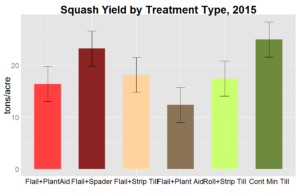

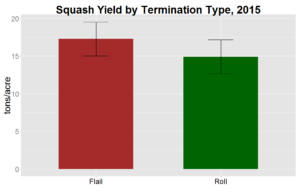
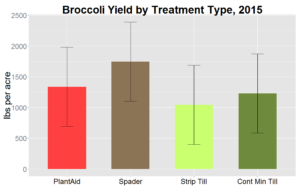
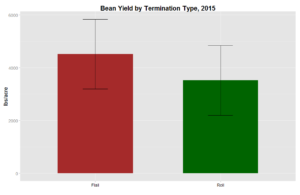

-
- PI Collins and graduate student David Sullivan attended the 2nd annual National Strip-Tillage Conference, Iowa City, IA, to examine strip tillage equipment opportunities.
- A PTO-powered strip tiller was designed and a multivator purchased to use in the strip tillage treatment.
- Evaluate nitrogen cycling dynamics in reduced tillage organic systems:
- Nitrogen cycling and cover crop decomposition dynamics in vetch cover crop were examined with residue bags. Fertilizer was withheld from ½ of each plot in this experiment to better distinguish nitrogen contribution from cover crop. In the full tillage and strip tillage treatments residue bags were buried at 10 cm and in the no-till treatment bags were left on the soil surface.
- Bags were recovered at five times throughout the growing season and weighed. A subsample of the residue was ashed to account for soil contamination in the residue bags.
- Soils were sampled for nitrate testing each time bags were removed.
- Select cover crops and termination strategies for reduced tillage organic agriculture:
- A cover crop variety and termination timing experiment was performed with Kale as a cash crop. Terminating cover crops with organic methods generally requires waiting relatively late in the spring for cover crops to mature. The purpose of this experiment was to examine opportunities for pushing the termination earlier to increase the growing season for cash crops. The experiment was repeated at two sites and included three cover crop selections (common vetch, Aroostook rye, and rye-vetch mix), three termination dates (mid-April, early May, mid-May), and two tillage types (full-till and strip till).
- Develop and analyze strategies for long-term continuous reduced tillage in organic agriculture:
- In summer 2014 we transitioned one of our six original treatments in the long-term trial to a continuous organic reduced tillage treatment. Plots were planted to a summer cover crop of Sorghum X Sudan grass and we used a seed drill to plan winter cover crops through this cover crop. This worked well for rye, but vetch did not establish successfully.
- We followed the rye cover crop with beans and squash. Despite the poor vetch establishment we still proceeded with planting broccoli in these plots. We were successful in growing beans, squash, and broccoli in the continuous reduced-tillage plots.
- In summer 2015 we acquired a minimum till drill and used this to seed cover crops in fall 2015. Both vetch and rye have established well in the plots.
- Earthworm populations were higher in spring 2015 in the reduced tillage treatment analyzed (roll+plant aid) compared to the full till (flail+spader)
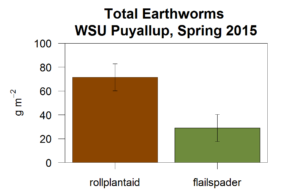
- Provide essential support to 15 western Washington organic producers implementing reduced tillage techniques on their farms.
- We conducted one on-farm research trial and one on-farm demonstration in summer 2015. The research trial at Kirsop Farm showed an increase in broccoli growth with strip tillage compared to rototilling (P value = 0.1; see attached figure).
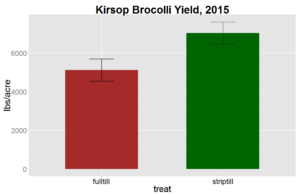
Impacts and Contributions/Outcomes
- We released two updates through our Reduced Tillage in the Pacific Northwest Listserve, including an announcement of our April 25, 2016 Field Day (Jan272016) and an update on our intensive strip tillage and precision cover cropping work (Sept042015). These announcements each reached 160 people. We did not hold a field day in 2015, but we will host two in 2016 (see attachments)
- Research trials are planned for five farms in 2016. Cover crop seed was provided to the farmers and farmers have planted the seed in anticipation of the trial.
-
In 2015, Dr. Collins presented results from our research in several different venues, reaching hundreds of people across the region and nationally.
- February 2, 2015, Organicology Conference, Portland Oregon; 80 participants in person and approximately 100 participants in concurrent webinar.
- April 7, 2015, National Webinar to NRCS Employees; approximately 100 participants
- October 28, 2015, University of Washington Biology 240 class (The Urban Farm); 25 participants
- September 23, 2015, Pacific Lutheran University Biology 368 (Advanced Ecology); 20 participants
Collaborators:
Farmer
Jubilee Farm
229 W. Snoqualmie River Rd NE
Carnation, WA 98014
Office Phone: 4252224558
Soil Scientist
Washington State University
2606 W Pioneer
Puyallup, WA 98371
Office Phone: 2534454512
Soil Scientiest
Washington State University
2606 W Pioneer
Puyallup, WA 98371
Office Phone: 2534454588
Extension Educator
Washington State University
600128th St, SE
Everett, WA 98208
Office Phone: 4253576012
Farmer
Terra Verde Farm
806 Chestnut Street
Everson, WA 98247
Office Phone: 3603932520
Extension Educator
Washington State University
1000 N FOREST ST, SUITE 201 3049 S. 36th Street
Bellingham, WA 98409
Office Phone: 3606766736
Farmer
Filbert Acres
6625 Pioneer Way E
Puyallup, WA 98371
Office Phone: 2533897884